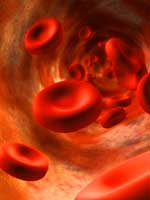May 16 2008
Nanotechnology researchers at UC Davis have shown that they can use a red blood cell to calibrate a sensitive instrument, an atomic force microscope.

"It turns around the rules of nanotechnology, by using biology to calibrate an instrument," said Volkmar Heinrich, assistant professor in the Department of Biomedical Engineering at UC Davis and co-author of the paper with graduate student Chawin Ounkomol.
An atomic force microscope uses a tiny lever that runs over the surface of an object. Small deflections of the tip are read and translated to produce an image of the object's surface. However, accurate calibration of the springiness of the tip is difficult.
Heinrich and Ounkomol used individual red blood cells sucked onto the end of a pipette to push the lever. The lab has previously developed a model that calculates the exact forces needed to squeeze a red blood cell by a certain amount. They could therefore use the red blood cell to very accurately calibrate the springiness of the atomic force microscope cantilever.
Heinrich does not see the technique as a new way to calibrate these instruments, but it does show that the red blood cell can be used as an accurate force transducer, he said, and could be used as a tool to measure forces between individual molecules and cells or between molecules. Those measurements can advance our understanding of cell biology, for example how cancers spread or how immune cells enter tissues to fight infection.